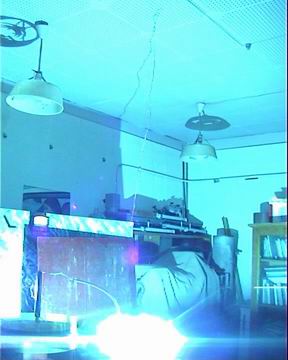
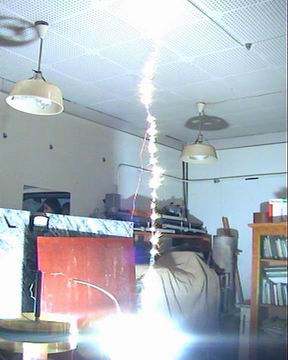
Gradually about allģ
Condensation of nonideal dust plasma at the erosive discharge accompanied by burning
1. The laboratory ball lightning on the basis of nonideal dust plasma
has a number of features. The principal ones are, firstly, too low density by several orders lower than air density, which is to make for nonequilibrium of heterogeneous discharge giving rise to it, secondly, presence during the protracted relaxation stage of characteristic internal source which utilizes mainly heterogeneous catalytic energy-release at the recombination, molarization ahd combustion of trapped gaseous matter having played the role of relatively cold dielectric during the discharge at the burning-through mode. The low rate of predominant heterogeneous catalytic reactions of gaseous constituent at the relatively low concentration of condensed phase demands sufficiently low temperature of a gas and a low concentration of gaseous active constituent that is to determine accordingly too low energy density of such objects at an atmospheric pressure. However the maintenance of high nonideality of "dust-gas plasma" that would suffice to guarantee even only an object view as analogue of a fireball is to demand so high rate of energy-release which comes about in known discharges only in the beginning of the period of relaxation. Therefore under atmospheric pressure the objects on a basis of dust-gas plasma can be long-living only in the presence of external energy source (e.g. DC discharge under thunderstorm conditions) or internal nuclear source (e.g. unstable or excited nuclei).For perfection of characteristics of laboratory plasma-chemical fireball the condensed systems of repeatedly lowered density (aerogel) have significant advantage in comparison with a dust-gas substance. First of all it is connected with the fact that the maintenance by them of character of the phase state does not demand a power consumption. Other essential peculiarity is their ability to burning inhibition down to smouldering without loss of explosion ability, e.g. as a result of mechanical destruction of structure by external influence or on reaching of critical value by internal overpressure. Last remark concerns to porous aerogels as against those threadlike ones which have no closed emptiness even in small spatial scale.
Having in view gaseous overpressure filling aerogel as a source of chemical energy, one can't pay no attention to hydrogen. It is caused not only by its high calorific capacity and not only by an arising its excessive concentration at the laboratory electric discharge in wet air or in humid atmosphere under influence of stormy, space or underground activity, but also by an opportunity to pump it into the porous structures by means of the "proton pump" of double electric layer at their surface.
2. The getting of an object on the basis of dust plasma externally similar to the natural prototype even in a small time interval demands to take into account in addition to general conditions also some rather delicate regime circumstances. The getting of aerogel with specific properties is more complicated problem, the essential simplification of it would be promoted by a finding of the basic conditions at which such state of substance is energy-favourable. Steadier aerogel states as intermediate between liquid and gaseous are realized at a high pressure of the closed erosive discharge. There is other such process being more accessible to visualization: it's a burning. The incomplete combustion is the circumstance making for appearance of the structural leavings which take place, for example, at lowered temperature and oxygen deficiency.
Probably, difficulties to form aerogel out of nonideal dust plasma are defined first of all by density difference: the density of aerogel is higher. If so one can assume that accumulation of erosive substance within the discharge, for example, due to increase of one's duration, should result in increase of its lifetime, at achievement of the critical density - by spurt.
The experimental material given below serves as demonstration of this interesting phenomenon.
3. Autonomous objects on the basis of dust-gas plasma appearing at the burning of copper wires were got by
A.L. Pirozerski. In suggested experiment the enameled copper wire 0.35 mm in diameter and by length not much larger 2 m was used. For achievement of external similarity with lightning over the sea and modelling of a damp-atmosphere area it settled down vertically between a ceiling and a basin with a salt water which was used as the anode and discharge resistor. Into a circuit of discharge of the capacitor in 2.55 mF being charged up to 4-4.5 kV the throttle 7.6 mH having been combined constructively with an incendiary transformer was entered for creation of initial breakdown between the water surface and the end of freely hanging wire.The discharge occurs as follows. After breakdown the wire is being heated by a current (
fig.1.1) and fused almost simultaneously in a number of points (fig.1.2), between the nearest ends of parts of a wire the erosive discharges which are carrying away molten metal are being established. The part of metal is being scattered via the splashes falling into water. Isolation in part is burning down, in part falling as the tubules having longitudinal break like a pod of an acacia. As a result of the discharge breaking approximately at 3.5 kV on a place of a wire the chain of floating objects is remaining (fig.1.3), their diameter is quickly decreasing and then it is being stabilized (fig.1.4).Their initial diameter reaches 20 mm, final - 2-5 mm, this means the change in 5-6 times in diameter and by two orders in volume (density). Intensity of radiation behaves similarly. In spite of the small size of objects the time of their life reaches several seconds. The majority objects is entrained by gas-dynamic fluxes of the atmosphere having been disturbed by the discharge, being arisen near to water, the objects shows the tendency to active moving (main part of shooting Ś 68 frames:
slideshow 720x576x24b jpg re-exposured by ACDSee 4.0 - 1.9 MB). The black flakes in the size some millimeters are to be found at a surface of a table under area of the discharge.


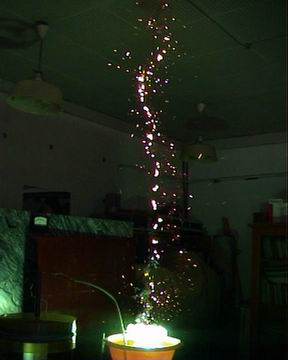
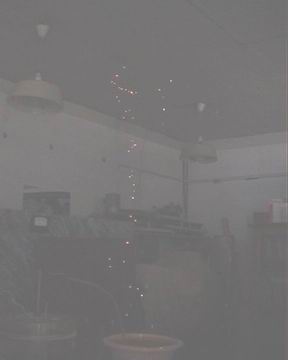
Having a good look at part of the discharge one can distinguish existence stages of the objects.
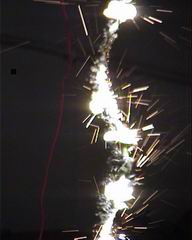
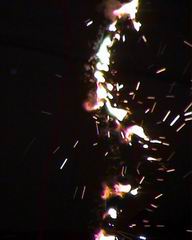
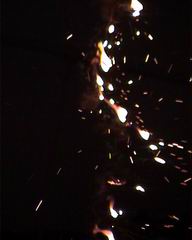
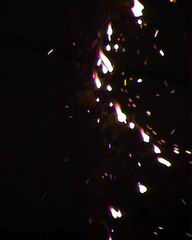
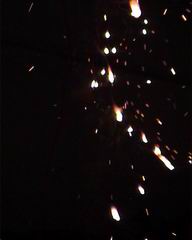
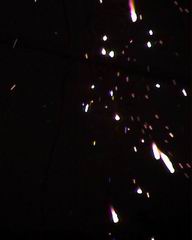
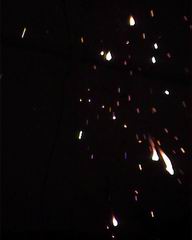
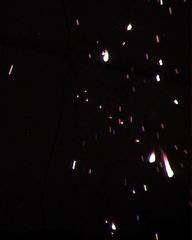
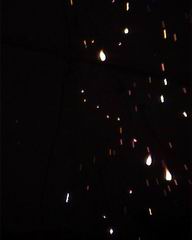
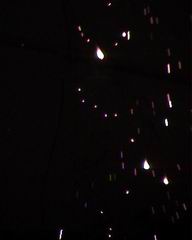
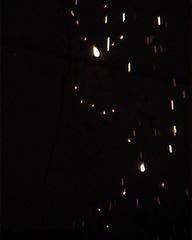
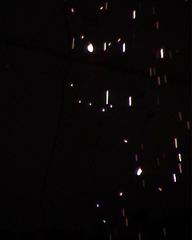
Luminescence over water is seen in the first 12 frames of videoshooting, presented in figs. 2.1-12 (main part of shooting Ś 57 frames: slideshow 720x576x24b jpg - 0.87 MB). Duration of this period sets a time scale distinctive for nonideal dust plasma with clusters of small size that allows to detach the period of mainly aerogel plasma.
It is possible to see that already on the second - third frame the full separation of objects is reached, at this moment they have the largest size. During following stage - torch stage, the objects decrease in one and a half - two time but have a torch almost disappearing to the end of this stage. Its duration for different objects is unequal, however by the end of the considered period the torch stage is finished everywhere. Fourth stage is characterized by peracute reduction of the size and intensity of radiation which in the subsequent longest period are stabilized on low rate of a relaxation.
Considering in the rough approximations that duration of every stage is proportional to the size of such fireball, it is possible to estimate some parameters of a fireball of the average size 10 - 20 cm.
Than time of possible separation of initial plasma volume to some independent objects - 0.5 - 1 s, initial diameter is 0.5 - 1 m, duration of a torch stage - 3.5 - 7.0 s, maximal length of a torch (including near infrared) - 1 - 2 m, duration of a transitive stage - 1 - 2 s and full duration of existence - 50 - 100 s.
4. Essential distinction between dust and aerogel plasma allows to hope that the accumulation of substance within object at the erosive discharge can be accompanied not only by increase of its relaxation time as a whole but also by separation in it of areas with discriminated properties. Undoubtedly, it is possible to attribute to effects of a similar sort the formation of "envelope", in particular, in the object being created in Gatchina discharge. Now we offer other similar example for this discharge.
For increase of energy and duration of the discharge the capacity of the storage was lead up till 2.55 mF, against 0.8 mF of old variant and 0.6 mF of Gatchina's one. The water volume had diameter about a half and depth about a quarter of meter. For expected increase of nonideality the discharge was carried out at temperature of water and air in a laboratory hardly was higher 0OC. At an initial voltage 5 kV the store gave about 25 kJ.

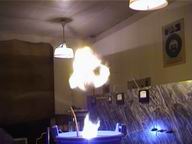
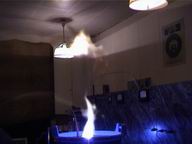
As a result of the discharge the bright ball by diameter about third of the meter appeared hanging over water (fig. 3.1). During disintegration the ball lost the shape (fig. 3.2) and threw out upwards an object in the size about 10 cm (fig. 3.3) lifetime of which was longer by a quarter of a second (full shooting slideshow 480x640 jpg - 1.2 MB).
The investigations had been carried out under science
collaboration treaty with PNPI (Gatchina).